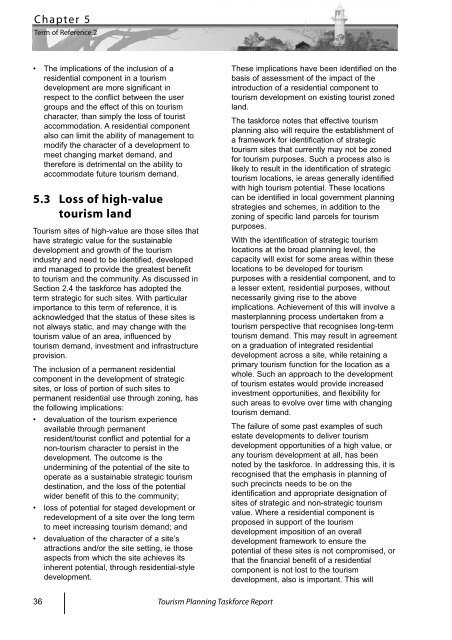Tourism Planning Taskforce Report - Western Australian Planning ...
Tourism Planning Taskforce Report - Western Australian Planning ...
Tourism Planning Taskforce Report - Western Australian Planning ...
- No tags were found...
Create successful ePaper yourself
Turn your PDF publications into a flip-book with our unique Google optimized e-Paper software.
Chapter 5Term of Reference 2• The implications of the inclusion of aresidential component in a tourismdevelopment are more significant inrespect to the conflict between the usergroups and the effect of this on tourismcharacter, than simply the loss of touristaccommodation. A residential componentalso can limit the ability of management tomodify the character of a development tomeet changing market demand, andtherefore is detrimental on the ability toaccommodate future tourism demand.5.3 Loss of high-valuetourism land<strong>Tourism</strong> sites of high-value are those sites thathave strategic value for the sustainabledevelopment and growth of the tourismindustry and need to be identified, developedand managed to provide the greatest benefitto tourism and the community. As discussed inSection 2.4 the taskforce has adopted theterm strategic for such sites. With particularimportance to this term of reference, it isacknowledged that the status of these sites isnot always static, and may change with thetourism value of an area, influenced bytourism demand, investment and infrastructureprovision.The inclusion of a permanent residentialcomponent in the development of strategicsites, or loss of portion of such sites topermanent residential use through zoning, hasthe following implications:• devaluation of the tourism experienceavailable through permanentresident/tourist conflict and potential for anon-tourism character to persist in thedevelopment. The outcome is theundermining of the potential of the site tooperate as a sustainable strategic tourismdestination, and the loss of the potentialwider benefit of this to the community;• loss of potential for staged development orredevelopment of a site over the long termto meet increasing tourism demand; and• devaluation of the character of a site’sattractions and/or the site setting, ie thoseaspects from which the site achieves itsinherent potential, through residential-styledevelopment.These implications have been identified on thebasis of assessment of the impact of theintroduction of a residential component totourism development on existing tourist zonedland.The taskforce notes that effective tourismplanning also will require the establishment ofa framework for identification of strategictourism sites that currently may not be zonedfor tourism purposes. Such a process also islikely to result in the identification of strategictourism locations, ie areas generally identifiedwith high tourism potential. These locationscan be identified in local government planningstrategies and schemes, in addition to thezoning of specific land parcels for tourismpurposes.With the identification of strategic tourismlocations at the broad planning level, thecapacity will exist for some areas within theselocations to be developed for tourismpurposes with a residential component, and toa lesser extent, residential purposes, withoutnecessarily giving rise to the aboveimplications. Achievement of this will involve amasterplanning process undertaken from atourism perspective that recognises long-termtourism demand. This may result in agreementon a graduation of integrated residentialdevelopment across a site, while retaining aprimary tourism function for the location as awhole. Such an approach to the developmentof tourism estates would provide increasedinvestment opportunities, and flexibility forsuch areas to evolve over time with changingtourism demand.The failure of some past examples of suchestate developments to deliver tourismdevelopment opportunities of a high value, orany tourism development at all, has beennoted by the taskforce. In addressing this, it isrecognised that the emphasis in planning ofsuch precincts needs to be on theidentification and appropriate designation ofsites of strategic and non-strategic tourismvalue. Where a residential component isproposed in support of the tourismdevelopment imposition of an overalldevelopment framework to ensure thepotential of these sites is not compromised, orthat the financial benefit of a residentialcomponent is not lost to the tourismdevelopment, also is important. This will36 <strong>Tourism</strong> <strong>Planning</strong> <strong>Taskforce</strong> <strong>Report</strong>

















